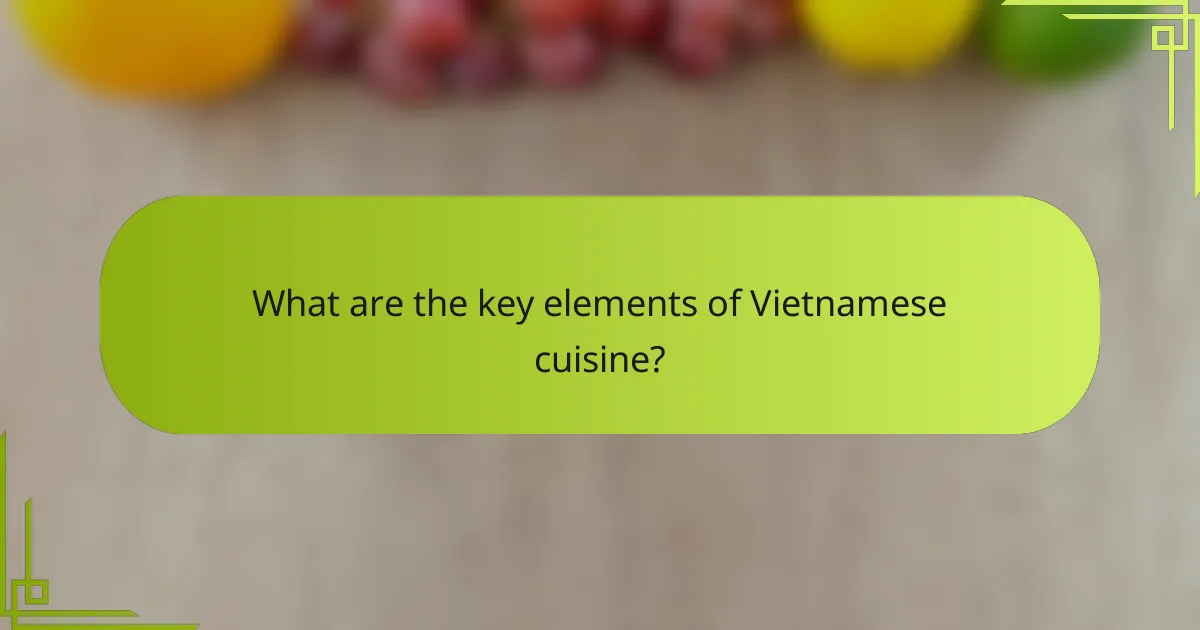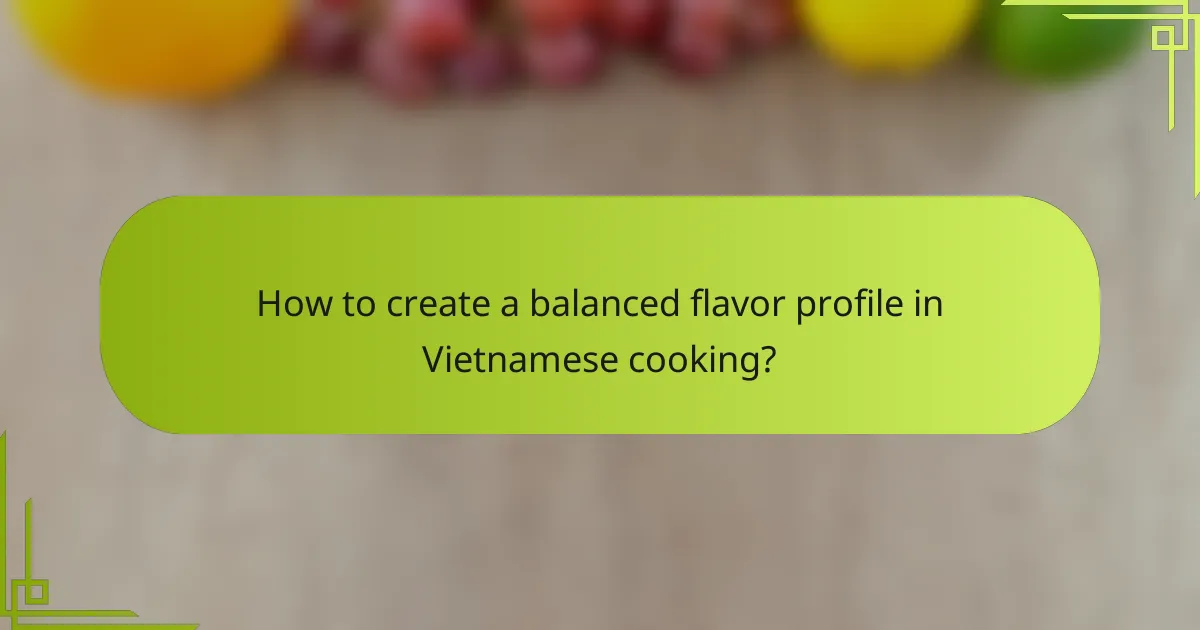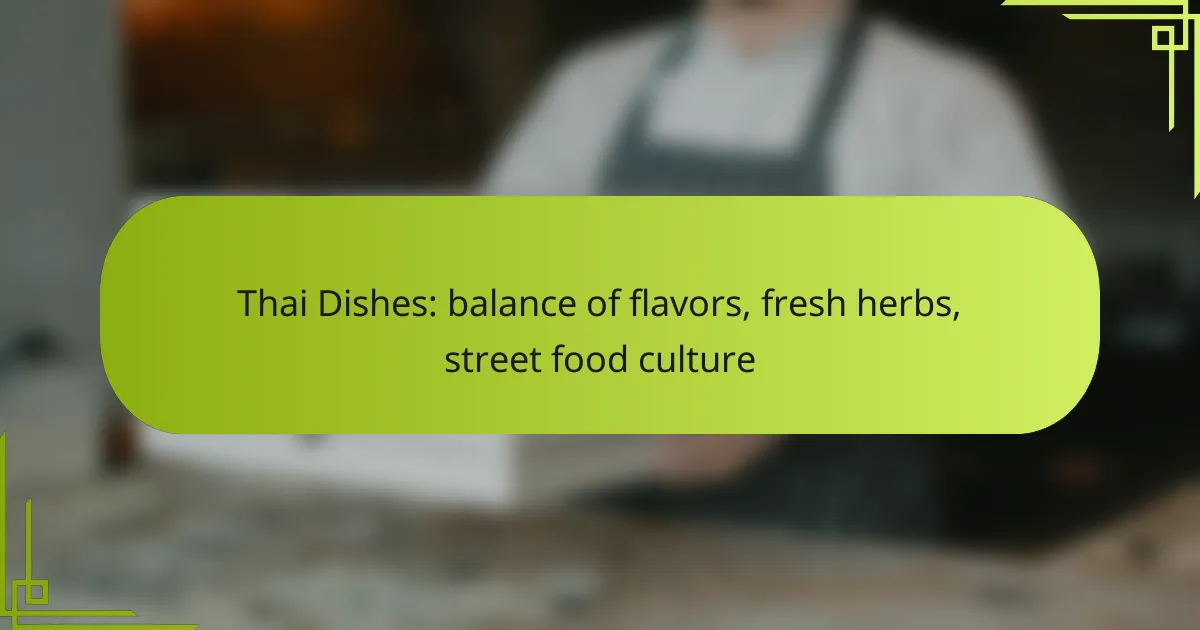Vietnamese cuisine is renowned for its vibrant use of fresh herbs and a meticulous balance of flavors, creating dishes that are both aromatic and satisfying. This culinary tradition is deeply intertwined with the country’s lively street food culture, where popular dishes showcase unique combinations and reflect the rich heritage of Vietnam. Each meal is an experience, highlighting the freshness and complexity that define this beloved cuisine.

What are the key elements of Vietnamese cuisine?
Vietnamese cuisine is characterized by its use of fresh herbs, a careful balance of flavors, and a vibrant street food culture. These elements combine to create dishes that are both aromatic and flavorful, reflecting the country’s rich culinary traditions.
Fresh herbs
Fresh herbs are a cornerstone of Vietnamese cooking, adding brightness and complexity to dishes. Common herbs include cilantro, mint, basil, and perilla, which are often used in salads, soups, and spring rolls.
When preparing Vietnamese meals, consider using a variety of herbs to enhance flavor. For instance, a bowl of pho typically features fresh herbs served on the side, allowing diners to customize their experience.
Balance of flavors
The balance of flavors in Vietnamese cuisine is achieved through a harmonious blend of sweet, sour, salty, and spicy elements. Dishes often incorporate ingredients like fish sauce, lime juice, and sugar to create this complexity.
For example, a classic dish like bánh xèo (Vietnamese pancakes) combines savory elements with the freshness of herbs and the tanginess of dipping sauces. Aim for a well-rounded flavor profile when cooking to capture the essence of Vietnamese cuisine.
Street food culture
Street food is an integral part of Vietnamese culture, offering a wide variety of affordable and delicious options. Vendors serve everything from bánh mì sandwiches to phở and fresh spring rolls, making it easy to enjoy local flavors on the go.
When exploring street food, look for busy stalls with high turnover, as this often indicates freshness and quality. Don’t hesitate to try different dishes to experience the full range of flavors that Vietnamese street food has to offer.

How do fresh herbs enhance Vietnamese dishes?
Fresh herbs are essential in Vietnamese cuisine, adding vibrant flavors and aromas that elevate dishes. They provide a balance of freshness, complexity, and texture, making meals more enjoyable and nutritious.
Common herbs used
Vietnamese dishes often feature a variety of fresh herbs, each contributing unique flavors. Common herbs include cilantro, mint, Thai basil, and perilla. These herbs are typically used in salads, soups, and as garnishes for various dishes.
For example, pho is often served with fresh basil and bean sprouts, while banh mi sandwiches include cilantro and jalapeños. The combination of these herbs enhances the overall taste and presentation of the meals.
Health benefits of herbs
Fresh herbs not only enhance flavor but also offer numerous health benefits. Many herbs are rich in vitamins, antioxidants, and anti-inflammatory properties, contributing to overall well-being. For instance, mint aids digestion, while cilantro is known for its detoxifying effects.
Incorporating a variety of herbs into your diet can help boost your immune system and improve heart health. Aim to include different herbs in your meals to maximize their health benefits while enjoying the distinctive flavors they bring to Vietnamese cuisine.

What are popular Vietnamese street foods?
Popular Vietnamese street foods are known for their vibrant flavors, fresh herbs, and unique combinations that reflect the country’s culinary heritage. These dishes are often enjoyed on the go and showcase the balance of flavors that Vietnamese cuisine is famous for.
Phở
Phở is a traditional Vietnamese noodle soup that typically consists of broth, rice noodles, herbs, and meat, usually beef or chicken. The dish is celebrated for its aromatic broth, which is simmered for hours with spices like star anise and cinnamon, creating a rich flavor profile.
When enjoying phở, consider the garnishes such as fresh basil, lime, and chili that enhance the dish. Street vendors often serve it in generous portions, making it a satisfying meal at any time of day.
Bánh mì
Bánh mì is a Vietnamese sandwich that combines a crispy baguette with a variety of fillings, including meats, pickled vegetables, and fresh herbs. This fusion of French and Vietnamese culinary traditions results in a flavorful and portable meal.
Common fillings include grilled pork, chicken, or tofu, paired with cilantro, cucumber, and spicy mayonnaise. Street vendors often offer a range of options, allowing for customization based on personal preferences.
Gỏi cuốn
Gỏi cuốn, also known as Vietnamese spring rolls or fresh spring rolls, are made with rice paper wrapped around a mixture of ingredients such as shrimp, herbs, and vermicelli noodles. They are served cold and are often accompanied by a dipping sauce, typically hoisin or peanut sauce.
These rolls are a healthy option, emphasizing fresh ingredients and minimal cooking. When purchasing gỏi cuốn from street vendors, look for those that are made fresh to ensure the best flavor and texture.

How to create a balanced flavor profile in Vietnamese cooking?
Creating a balanced flavor profile in Vietnamese cooking involves harmonizing sweet, sour, salty, and spicy elements. This balance enhances the freshness of ingredients and reflects the cuisine’s emphasis on vibrant, layered tastes.
Sweet, sour, salty, and spicy components
In Vietnamese dishes, sweet flavors often come from sugar or fruits, while sourness is achieved through ingredients like lime juice or vinegar. Salty elements typically derive from fish sauce or soy sauce, and spiciness can be introduced with fresh chilies or chili paste. The key is to ensure that no single flavor dominates; instead, they should complement each other.
A classic example is the popular dish, phở, where the broth balances these four components, creating a complex yet harmonious taste. When preparing sauces or marinades, consider starting with equal parts of each flavor and adjusting according to your palate.
Ingredient pairings
Ingredient pairings are crucial for achieving a balanced flavor profile in Vietnamese cooking. Fresh herbs like cilantro, mint, and basil are often paired with meats and vegetables to enhance flavor and provide freshness. For instance, combining grilled pork with fresh herbs and pickled vegetables creates a delightful contrast of flavors and textures.
Another effective pairing is the use of rice noodles with a variety of toppings, such as shrimp, peanuts, and lime, which together deliver a well-rounded taste experience. Experimenting with different combinations can help you discover unique flavors while maintaining the essential balance of sweet, sour, salty, and spicy elements.

What are the best places to experience Vietnamese street food in London?
London offers a vibrant scene for experiencing Vietnamese street food, with various markets and restaurants showcasing authentic flavors. Key locations include bustling street food markets and popular restaurants known for their traditional dishes.
Street food markets
Street food markets are a fantastic way to immerse yourself in Vietnamese cuisine. Places like Camden Market and Borough Market often feature stalls offering fresh bánh mì, pho, and spring rolls. These markets provide a casual atmosphere where you can sample a variety of dishes in one visit.
When visiting, look for vendors that use fresh herbs and ingredients, as these are essential to authentic Vietnamese flavors. Don’t hesitate to ask for recommendations from the vendors to discover hidden gems.
Popular restaurants
Several restaurants in London specialize in Vietnamese street food, providing a sit-down experience with a focus on traditional recipes. Restaurants like Pho and Viet Food are well-known for their extensive menus that include classic dishes such as pho and bun cha.
Consider visiting during lunch hours for special deals or set menus that offer great value. Many of these restaurants also emphasize the balance of flavors, ensuring that each dish is a true representation of Vietnamese culinary traditions.

How can you incorporate Vietnamese flavors at home?
To incorporate Vietnamese flavors at home, focus on using fresh herbs, balancing flavors, and embracing the street food culture. Start by experimenting with essential ingredients and techniques that define this vibrant cuisine.
Essential ingredients
Key ingredients in Vietnamese cooking include fresh herbs like cilantro, mint, and basil, which add brightness and depth to dishes. Other staples are fish sauce, rice noodles, and various proteins such as pork, chicken, or tofu, which form the base of many meals.
When shopping for these ingredients, consider visiting local Asian markets for authentic products. Look for high-quality fish sauce and fresh herbs, as they can significantly enhance the flavor of your dishes.
Incorporate these ingredients into simple recipes like pho or banh mi, where the balance of flavors—sweet, salty, sour, and spicy—creates a delightful culinary experience. Experimenting with these elements will help you achieve the essence of Vietnamese cuisine at home.










